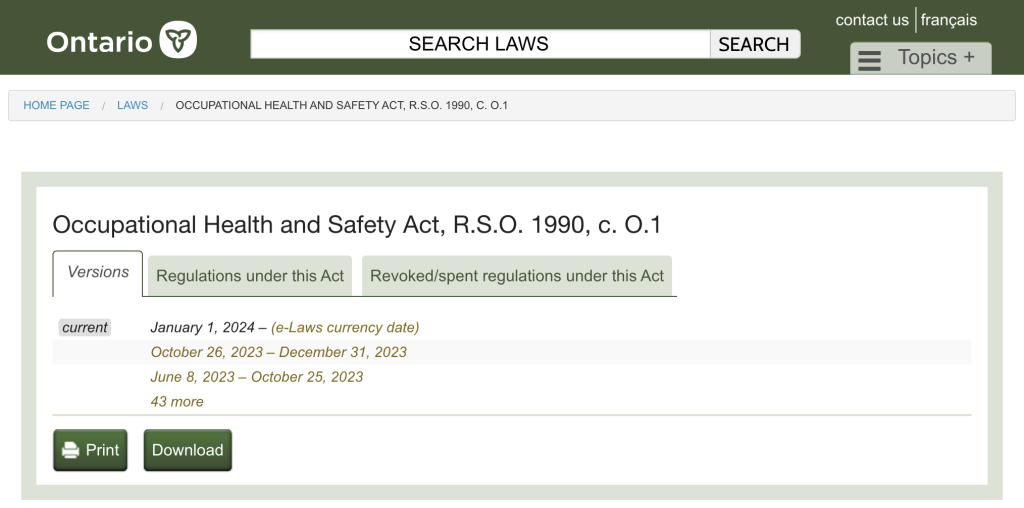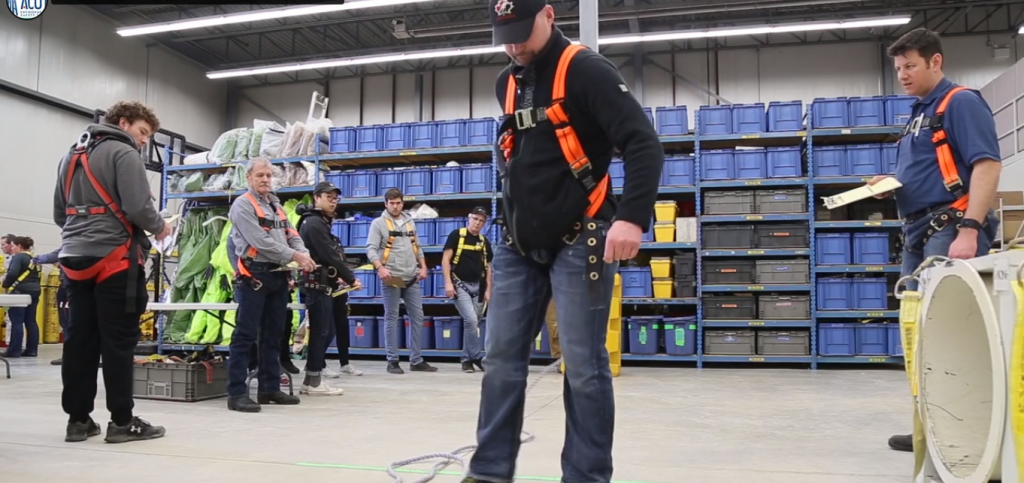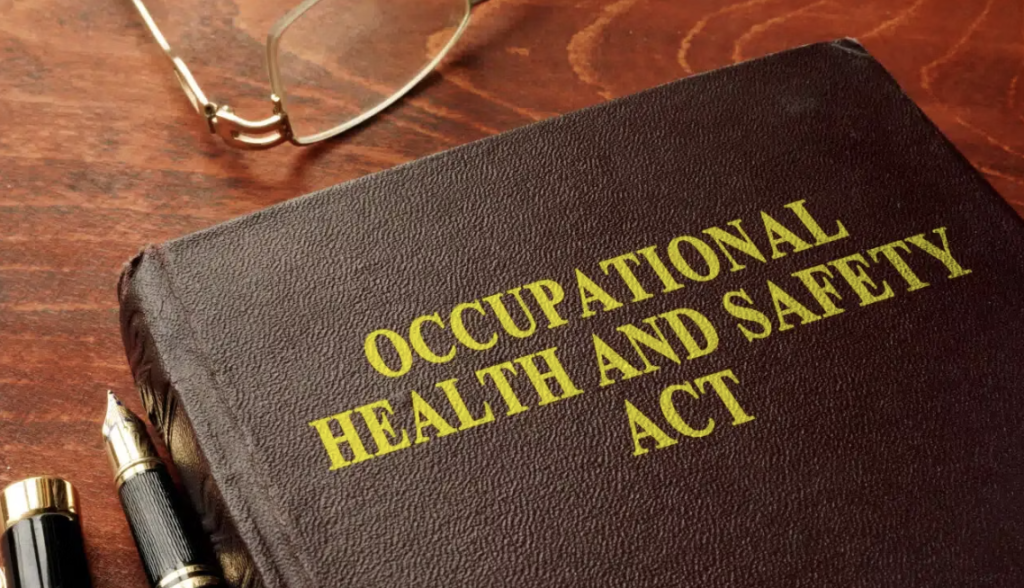Work Site Safety – Expectations & Training
Navigating the landscape of occupational health and safety is crucial for every employer. Compliance with the Occupational Health and Safety Administration (OHSA) regulations not only ensures the well-being of employees but also protects businesses from legal and financial repercussions. This guide provides essential insights into OHSA compliance, enforcement, and the steps employers must take to maintain a safe and compliant workplace.
Click on each corresponding link to jump ahead:
3) Employer Responsibilities Under OHSA
4) Key OHSA Regulations to Know
6) Best Practices for OHSA Compliance
Looking for work site safety training? ACUTE can help! Our trainers have real-world experience and a passion for teaching. Expect engaging, hands-on sessions that bring safety concepts to life. Contact us today!
1) Introduction

Importance of Workplace Safety
Workplace safety is not just a regulatory requirement but a fundamental aspect of running a successful business. Ensuring a safe working environment is crucial for several reasons. First and foremost, it protects employees from potential harm and life-threatening injuries. According to recent statistics, workplace accidents in Canada result in thousands of injuries and fatalities each year. For example, the Association of Workers’ Compensation Boards of Canada (AWCBC) reported that in 2020 alone, there were over 250,000 accepted claims for lost time due to work-related injuries or diseases. This highlights the significant impact of workplace incidents on employees’ health and well-being.
Beyond the human cost, workplace accidents can have severe financial repercussions for businesses. The direct costs include medical expenses and compensation payouts, while indirect costs involve lost productivity, increased insurance premiums, and potential fines for non-compliance with safety regulations. Moreover, companies that prioritize workplace safety often experience higher employee morale, reduced absenteeism, and improved overall productivity. In essence, a safe workplace is a more efficient and profitable one.
For more information on the financial impact of workplace accidents, the Canadian Centre for Occupational Health and Safety (CCOHS) provides valuable insights and resources.
Role of OHSA (Occupational Health and Safety Act)
The Occupational Health and Safety Act (OHSA) plays a pivotal role in ensuring workplace safety across Canada. Enacted to promote and protect the health and safety of workers, OHSA sets out the rights and duties of all parties in the workplace, including employers, supervisors, and employees. The Act provides a framework for identifying and managing workplace hazards, conducting safety training, and implementing preventive measures to reduce the risk of accidents and injuries.
OHSA’s scope is comprehensive, covering a wide range of industries and occupational settings. It mandates that employers must take every reasonable precaution to protect workers, including providing proper training, ensuring safe use of equipment, and maintaining a hazard-free environment. The Act also empowers employees with the right to know about potential hazards, the right to participate in safety initiatives, and the right to refuse unsafe work.
In Canada, the enforcement of OHSA is overseen by provincial and territorial governments, each responsible for regulating workplaces within their jurisdiction. This means that while the core principles of OHSA are consistent nationwide, specific regulations and enforcement practices may vary by region. For detailed information on provincial regulations, you can visit Ontario’s Ministry of Labour, Immigration, Training and Skills Development or WorkSafeBC.
By adhering to OHSA regulations, employers not only comply with legal requirements but also demonstrate their commitment to safeguarding their workforce, thereby fostering a culture of safety and accountability within their organizations.
2) Overview of OHSA

History and Background
The Occupational Health and Safety Act (OHSA) is a cornerstone of workplace safety in Canada. Its development and evolution have been shaped by the growing recognition of the importance of protecting workers’ health and safety. The history of OHSA dates back to the early 1970s when industrial accidents were alarmingly frequent, leading to heightened public awareness and demand for stronger safety regulations.
The first significant milestone came in 1974 with the establishment of the Ham Commission, which was tasked with investigating safety in Ontario mines after a series of fatal accidents. The Commission’s report laid the groundwork for modern occupational health and safety legislation. One of its key recommendations was the creation of a regulatory framework that would clearly define the responsibilities of employers, workers, and the government.
In response, the Ontario government passed the OHSA in 1978, marking a significant shift towards a more structured and enforceable approach to workplace safety. This act has since influenced other provinces and territories to develop similar legislation, ensuring a unified approach to occupational health and safety across Canada. Over the years, OHSA has been amended multiple times to address emerging safety concerns and to incorporate advances in safety practices and technology. For more detailed historical context, visit Ontario’s Ministry of Labour, Immigration, Training and Skills Development.
Structure of the Act
The OHSA is comprehensive, encompassing several key components that outline the responsibilities and rights of all workplace parties. Understanding the structure of the Act is crucial for employers and employees alike to ensure compliance and foster a safe working environment.
1. General Duties and Responsibilities:
– The OHSA outlines the general duties of employers, supervisors, and workers. Employers are required to take every reasonable precaution to protect workers, ensure equipment is safe, and provide adequate training and supervision. Supervisors must ensure that workers comply with the Act and are aware of any potential hazards. Workers are responsible for following safety protocols and reporting any unsafe conditions.
2. Rights of Workers:
– The Act enshrines three fundamental rights for workers: the right to know about hazards in the workplace, the right to participate in identifying and resolving safety issues, and the right to refuse unsafe work. These rights empower workers to take an active role in maintaining their own safety and the safety of their colleagues.
3. Workplace Hazard Assessment:
– Employers must regularly conduct assessments to identify potential hazards. This involves evaluating both physical hazards (such as machinery and equipment) and environmental hazards (such as chemical exposure or ergonomic risks). The findings from these assessments must be documented and addressed promptly.
4. Safety Committees and Representatives:
– The OHSA requires the establishment of Joint Health and Safety Committees (JHSCs) in workplaces with 20 or more employees. These committees, composed of both worker and management representatives, are responsible for conducting regular workplace inspections, addressing safety concerns, and making recommendations for improvements. In smaller workplaces, a health and safety representative may be appointed.
5. Enforcement and Penalties:
– The Act grants inspectors the authority to enter workplaces, conduct inspections, and issue orders to rectify any non-compliance. Failure to comply with OHSA regulations can result in significant penalties, including fines and imprisonment for severe violations. This enforcement mechanism ensures that workplace safety remains a top priority for all organizations.
The OHSA is a living document, periodically updated to reflect new safety standards and best practices. For the latest version of the Act and detailed definitions of its terms, refer to the Government of Ontario’s e-Laws or the specific OHSA regulations applicable in your province or territory.
3) Employer Responsibilities Under OHSA

The Occupational Health and Safety Act (OHSA) places significant responsibilities on employers to ensure the safety and well-being of their workers. Understanding these obligations is crucial for creating a safe work environment and preventing workplace injuries and accidents.
General Duties of Employers
Employers are tasked with the fundamental duty of providing a safe work environment for their employees. This includes identifying and addressing potential hazards, implementing safety protocols, and providing necessary training and supervision to mitigate risks. By prioritizing safety, employers can create a culture of awareness and accountability, reducing the likelihood of workplace incidents.
Specific Requirements
In addition to general duties, employers must adhere to specific requirements outlined in OHSA regulations. This includes compliance with safety standards relevant to their industry, such as equipment maintenance, hazard communication, and emergency preparedness. Implementing comprehensive safety programs tailored to the unique needs of the workplace is essential for maintaining compliance and ensuring the well-being of employees.
Reporting and Documentation
Incident reporting and documentation are integral components of OHSA compliance. Employers are obligated to report workplace incidents, injuries, and near misses to the relevant authorities, such as the Occupational Health and Safety Act (OHSA) or other regulatory agencies. Additionally, maintaining accurate records of safety inspections, training sessions, and corrective actions taken is essential for demonstrating compliance and identifying areas for improvement.
By understanding and fulfilling their responsibilities under OHSA, employers can create a safer and healthier work environment for their employees, reduce the risk of accidents and injuries, and protect their businesses from potential legal liabilities. Prioritizing safety not only benefits employees but also contributes to organizational success and sustainability in the long term.
4) Key OHSA Regulations to Know

Workplace Hazard Assessment
Workplace hazard assessment is a critical aspect of OHSA compliance. It involves identifying and evaluating potential hazards in the workplace, including physical, chemical, biological, and ergonomic risks. Conducting regular safety audits and inspections helps ensure that hazards are promptly identified and addressed to maintain a safe working environment for employees.
Employee Training and Education
Employee training and education play a vital role in promoting workplace safety. OHSA regulations mandate the implementation of mandatory safety training programs to equip employees with the knowledge and skills necessary to recognize and mitigate workplace hazards. Ongoing education initiatives ensure that employees stay informed about new safety protocols and best practices, empowering them to contribute to a culture of safety in the workplace.
Emergency Preparedness
Emergency preparedness is essential for ensuring the safety and well-being of employees in the event of a crisis or disaster. OHSA regulations require employers to develop comprehensive emergency plans that outline procedures for responding to emergencies such as fires, natural disasters, and chemical spills. Conducting regular evacuation drills and providing employees with training on emergency response protocols helps ensure a prompt and effective response in the event of an emergency.
Personal Protective Equipment (PPE)
Personal protective equipment (PPE) plays a crucial role in safeguarding employees from workplace hazards. OHSA regulations outline standards and requirements for PPE, including the types of equipment required for specific tasks and the employer’s responsibility to provide and maintain it. Employers must ensure that PPE is properly fitted, maintained, and used correctly to effectively protect employees from injury or illness.
Understanding and complying with these key OHSA regulations is essential for creating a safe and healthy work environment for employees. By prioritizing workplace hazard assessment, employee training, emergency preparedness, and the provision of personal protective equipment, employers can mitigate risks, prevent accidents, and ensure the well-being of their workforce.
5) Compliance and Enforcement

Inspections and Audits
OHSA inspectors play a crucial role in ensuring workplace safety by conducting regular inspections and audits. These professionals are responsible for assessing compliance with occupational health and safety standards. During an inspection, an OHSA inspector will typically:
- Review safety protocols and procedures.
- Examine workplace conditions and equipment.
- Interview employees and management about safety practices.
- Verify documentation related to safety training and incident reports.
To prepare for an OHSA inspection, employers should maintain thorough and up-to-date records of all safety measures and training programs. Ensuring that the workplace is consistently adhering to safety standards and addressing potential hazards proactively can help mitigate any issues during an inspection. Regular internal audits and employee training sessions are also essential practices for maintaining compliance.
Penalties for Non-Compliance
Non-compliance with OHSA regulations can lead to severe penalties, which vary based on the nature and severity of the violation. Types of penalties include:
- Fines: Financial penalties can range from minor fines for small infractions to substantial fines for serious violations.
- Shutdowns: In extreme cases where there is an immediate threat to worker safety, OHSA has the authority to shut down operations until the hazards are addressed.
For example, in one notable case, a construction company faced a $50,000 fine after repeated violations of fall protection standards resulted in multiple worker injuries. In another instance, a manufacturing plant was temporarily shut down due to inadequate machine guarding, which posed a significant risk to employees.
Appeals and Legal Processes
Employers have the right to appeal OHSA decisions if they believe a citation or penalty is unwarranted. The appeals process generally involves:
- Filing an Appeal: Employers must submit a formal appeal within a specified timeframe, typically 15 days from the receipt of the citation.
- Review and Hearing: The case will be reviewed, and a hearing may be scheduled where the employer can present evidence and argue their case.
- Final Decision: After reviewing the evidence and hearing arguments, an administrative law judge will issue a final decision.
Legal support can be crucial during the appeals process. Employers may seek the assistance of attorneys who specialize in occupational health and safety law to help navigate the complexities of the legal system and ensure a fair hearing.
Understanding and adhering to OHSA regulations not only helps avoid penalties but also fosters a safer and healthier work environment. Employers who prioritize compliance demonstrate a commitment to their employees’ well-being, which can lead to increased productivity and morale.
6) Best Practices for OHSA Compliance

Building a Safety-First Culture
Creating a safety-first culture is essential for effective OHSA compliance. Employers can encourage employee involvement in safety initiatives by:
- Safety Committees: Establishing safety committees that include employees from various departments can foster a sense of ownership and responsibility for workplace safety.
- Training and Education: Providing regular safety training sessions and educational workshops helps employees stay informed about best practices and emerging risks.
- Open Communication: Encouraging open communication channels where employees can report hazards and suggest improvements without fear of reprisal is crucial.
Leadership commitment to safety is equally important. Leaders should:
- Lead by Example: Demonstrate a commitment to safety by following all safety protocols and actively participating in safety initiatives.
- Allocate Resources: Ensure that adequate resources are allocated for safety training, equipment, and improvements.
- Recognize and Reward: Recognize and reward employees and teams who demonstrate exceptional commitment to safety.
Continuous Improvement
Maintaining OHSA compliance requires a commitment to continuous improvement. Employers should:
- Regular Reviews: Conduct regular reviews of safety policies and procedures to ensure they are up-to-date and effective. This includes analyzing incident reports and identifying areas for improvement.
- Technology Integration: Leverage technology to enhance safety management. Implementing safety management software can help track incidents, manage inspections, and monitor compliance more efficiently.
- Feedback Loops: Establish feedback loops where employees can provide input on safety measures, ensuring that policies remain relevant and effective.
External Resources and Support
Employers should not hesitate to seek external resources and support to bolster their OHSA compliance efforts. Consider:
- Consulting Experts: Engaging with safety consultants or experts who can provide tailored advice and support based on industry-specific challenges.
- Government Resources: Utilizing resources provided by OHSA and other governmental bodies, such as guidelines, training materials, and consultation services.
- Industry Associations: Joining industry associations and networks that offer resources, training, and support for safety management.
By adopting these best practices, employers can not only achieve compliance with OHSA regulations but also create a safer, more productive workplace for their employees.
7) Final Thoughts

OHSA compliance is fundamental to ensuring a safe and healthy workplace. Key takeaways for employers include:
- Understanding Compliance and Enforcement: Familiarity with the role of OHSA inspectors, the process of inspections, and the consequences of non-compliance is essential.
- Building a Safety-First Culture: Encouraging employee involvement and leadership commitment to safety can significantly enhance workplace safety.
- Continuous Improvement: Regularly reviewing and updating safety policies and leveraging technology are crucial for maintaining compliance.
- Utilizing External Resources: Consulting with safety experts and utilizing government and industry resources can provide additional support and guidance.
Final Thoughts
Prioritizing workplace safety is not just about regulatory compliance; it reflects a commitment to the well-being of employees and the overall success of the business. Adhering to OHSA regulations helps prevent accidents, reduces financial risks, and promotes a positive organizational culture. By embracing these practices, employers can ensure a safer, more productive workplace, ultimately leading to long-term benefits for both employees and the organization.
That’s where Acute Services comes in. With our expert-led training programs, we make OSHA compliance straightforward and manageable. Our team of experienced professionals will guide you through the intricacies of OSHA regulations, ensuring that your workplace meets all necessary safety standards. Visit acuteservices.com to learn more about how we can help you build a safer, more compliant workplace.
8) Additional Resources
Government and Official OHSA Resources
For detailed information on OHSA regulations in Canada, employers can visit the official Canadian Centre for Occupational Health and Safety (CCOHS) website at www.ccohs.ca. This site offers comprehensive resources, including guidelines, regulatory updates, and access to various OHSA documents. Additionally, the Canadian Government’s Occupational Health and Safety page provides valuable information on national safety standards and practices.
Industry Associations and Safety Organizations
Several Canadian industry associations and safety organizations provide valuable support and resources for employers seeking to enhance their safety programs:
- Canadian Society of Safety Engineering (CSSE): www.csse.org
- Phone: (437) 374-4340
- Workplace Safety & Prevention Services (WSPS): www.wsps.ca
- Phone: (877) 494-9777
- Institute for Work & Health (IWH): www.iwh.on.ca
- Phone: (416) 927-2027
Training and Certification Programs
To help employers stay compliant with OHSA regulations, numerous training and certification programs are available in Canada:
- CCOHS Training and Education: Offers various courses on occupational safety and health standards. More information can be found at www.ccohs.ca/products/courses/.
- Workplace Safety North (WSN) Training Programs: Provides a range of safety training courses and certifications. Details are available at www.workplacesafetynorth.ca.
- St. John Ambulance Workplace Safety Training: Offers certification in first aid, CPR, and AED. Information is available at www.sja.ca.
By leveraging these resources, employers can ensure they have the necessary knowledge and tools to maintain a safe and compliant workplace in Canada.

